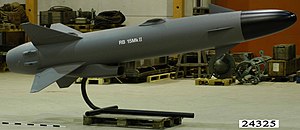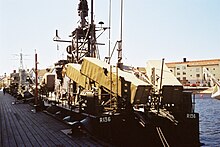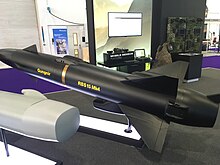| This article needs additional citations for verification. Please help improve this article by adding citations to reliable sources. Unsourced material may be challenged and removed. Find sources: "RBS 15" – news · newspapers · books · scholar · JSTOR (July 2013) (Learn how and when to remove this message) |
| RBS 15 | |
|---|---|
 RBS 15 RBS 15 | |
| Type | Surface to surface missile Air to surface missile Anti-ship missile Land-attack missile |
| Place of origin | Sweden |
| Service history | |
| In service | 1984–present |
| Used by | See operators |
| Production history | |
| Manufacturer | Saab Bofors Dynamics, Diehl Defence |
| Specifications | |
| Mass | 820–810 kg (with boosters) 660–650 kg (in flight) |
| Length | 4.35 m |
| Diameter | 50 cm |
| Wingspan | 1.4 m |
| Warhead | 200 kg HE blast and pre-fragmented warhead. |
| Detonation mechanism | impact or proximity |
| Engine | turbojet |
| Operational range | >70 km for RBS 15 Mk. I and II
>200 km for RBS 15 Mk. III >300 km for RBS 15 MkIV |
| Flight altitude | sea skimming |
| Maximum speed | 0.9 Mach subsonic |
| Guidance system | inertial, GPS, terminal active radar homing (J band) |
| Launch platform | naval ships, aircraft and land-based missile launchers |
The RBS 15 (Robotsystem 15) is a long-range fire-and-forget surface-to-surface and air-to-surface anti-ship missile. The later version Mk. IV has the ability to attack land targets as well. The missile was developed by the Swedish company Saab Bofors Dynamics.
History
The Swedish Navy earlier made the RB 08 anti-ship missiles with the Halland-class destroyers in the early 1960s. The main effect of Sweden's defence resolution of 1958 for the Swedish navy was restructuring into a lighter force consisting of fast attack craft (FAC) vessels and a halt to destroyer procurement. This posed a problem as the existing RB 08 missile required launch rails and a missile magazine in the destroyers, taking up space that was not available in smaller ships. Adding to the problems, each missile had to be individually prepared for launch and only two missiles could be on the launch rails at the same time. In comparison, the P-15 Termit (NATO codename Styx) missile used by the Soviet Union from the late 1950s (which was the expected adversary of RBS 15) stored the missiles in individual containers on deck with the missiles immediately available for launch. Tests were carried out on Plejad class FACs with a single bow-mounted RB 08 in the late 1960s, but they came to nothing.

Saab's next attempt at anti-ship missiles to equip the Norrköping class FACs of the Swedish navy was in 1978 under the project name "RB 04 Turbo", a development of the air force RB 04E missile with a turbofan engine, changed wing configuration and start rockets to take off from land. The initial proposal was rejected as inferior to the Harpoon missile. The project, under the leadership of Hans Ahlinder, then worked out a proposal for a missile with greater capabilities than the Harpoon, and superior performance to the American missile. To indicate that it was a new weapon the project name was changed from "RB 04 Turbo" to "RBS 15".

The first weapon contract was signed in 1979; at the last minute the Swedish government did not buy the Harpoon anti-ship missile, opting for an indigenous design. The first missiles were delivered to the Navy in June 1984, and the ship version RBS 15 Mk. I was introduced.

The Swedish Navy ordered the missile in 1984 to develop a coastal defense version of the RBS 15F. The missile was taken into Swedish Navy service as the 'Rb 15 by the Swedish Navy and became operational in 1985. The Swedish Air Force received their missiles a couple of years later. The original RBS 15 Mk. I was produced from 1985 to 1990.
Work on a further developed version, the RBS 15 Mk. II, began in the early 1980s, but it took until 1994 to get a development contract for the upgraded anti-ship missile. The Mk. II has the same range (70+ km), but the mid-course and terminal guidance system, as well as the radar and IR signature were upgraded. The Mk. II has been produced since 1998.
Development of the RBS 15 Mk. III began in the mid-1990s. It is produced by Saab in co-operation with Diehl Defence of Germany. Emphasis was put on increased range (due to larger fuel capacity and new fuel the range has been increased to some 200 km), improved accuracy (integrated GPS) and selectable priority targeting, which improved the weapon system's flexibility. The Mk. III was selected for the German Navy's Braunschweig-class corvettes. Finnish truck maker Sisu produces missile launch trucks for RBS 15. The Mk. III has been in production since 2004.
In March 2017 Saab received an order for a new generation anti-ship missile to replace the RBS 15, valued at 3.2 billion SEK. The following year, SAAB unveiled the RBS 15 Mk. IV Gungnir, again produced with Diehl. Unlike Mk. III, the Mk. IV Gungnir can be fired from a truck, making it capable of launching from air, sea, or land. Gungnir missiles have been ordered for the Swedish Navy, with the first weapons scheduled for delivery in the mid-2020s.
Development phase
The missile was developed from the RB 04 missile that was used by the Swedish air force. The front of the missile was retained, including the warhead, but the rear received new wings and a turbofan engine replaced the rocket previously used. The RBS 15 underwent trials on the missile FAC HSwMS Piteå from 1983 and became operational with the Swedish Navy in 1985. The Västergötland-class submarines were to have four vertical missile launch tubes for RBS 15 missiles in an extended hull, canceled due to budget constraints and to not fitting the way Swedish submarines operated.
Versions

- RBS 15 Mk. I
- Powered by a French Microturbo TRI-60 engine, with a thrust of 3.73 kN (380 khp/830 lbf). Range 70+ km
- RBS 15F
- An Mk. I adapted for air launch. Entered service in 1989.
- RBS 15 Mk. II
- Range 70+ km. Designed to be launched from a number of different platforms, such as land-based launchers, aircraft, and ships.
- RBS 15SF
- Mk. II version for Finland. Local designation MTO 85 (Meritorjuntaohjus 1985)
- RBS 15 Mk. III
- New turbojet engine Microturbo TRI 60-5 with 4.4 kN (990 lbf) of thrust, range over 200 km, with added land attack capability. New warhead (increased penetration and insensitive munitions qualification) from TDW. There is only a ship launched version. Production started in 2004. New oval launch tubes instead of the old box type.
- RBS 15F ER
- Aircraft launched version of the Mk. III
- RBS 15SF-3
- Finnish-Swedish modernization of the Finnish Mk. IISFs. Finnish designation MTO 85M. Range was increased to over 100 km, the changes further incorporated more waypoints and better ability to overcome obstacles.
- RBS 15 Mk. IV Gungnir
Range 300+ km (190+ mi), Navigation INS and Anti-Jam GPS, Target seeker J-band active radar, Launchable from air, land and sea

Ordered in March 2017 by Sweden. Has better range, a better seeker and lower weight. It has the ability to knock out a wide range of sea and land targets, all-weather capability and a modular design that allows for future upgrades. To be carried by Visby-class corvettes and JAS Gripen E. Will be delivered between 2017 and 2026 and fully operational in the mid-2020s. RBS 15Mk4 and RBS Mk4 Air was earlier known as RB 15Mk3+ & RB 15F-ER, RBS 15 Gungnir is the system level name.
Operators

Current operators


![]() Algeria – 65 RBS-15 Mk-3
Algeria – 65 RBS-15 Mk-3
Used by the Algerian National Navy on its two MEKO 200 frigates.
Primary weapon of the Croatian Navy for its five guided missile boats and three coastal systems mounted on Tatra trucks. In total, 48 Mk.I units are in service. Plans for upgrading 21 missiles to a standard incorporating elements from both the Mk.II and the Mk.III versions was cancelled in 2009 due to budget restraints but light software upgrades were continuously executed and have improved the missiles' navigation, precision and electronic defence. The latest of this upgrades was conducted in 2010 as part of usual service works. Unexpectedly though, in August 2014 the Croatian government decided to send at least 20 Croatian RBS 15 missiles through an overhaul program so as to keep them operational and current for another 10 years. The missiles are to receive upgrades to increase their range to about 90–100 km as well as to improve their guidance, precision and survivability against jamming. The missiles were successfully launched and destroyed their targets in live fire naval exercises in 2015, 2016 and 2018.
The Finnish Navy operates RBS 15SF-III (Mk. IIs, designation MTO 85) that have undergone various upgrades during their lifetime. The missiles are carried by the Hamina-class missile boats and the Rauma-class missile boats. Finland also operates the missiles from Sisu trucks for mobile coastal defense.
 Germany – 129 RBS-15 Mk-3
Germany – 129 RBS-15 Mk-3
The German Navy has chosen the Mk. III to equip its Braunschweig-class corvettes in 2005. Saab has received an additional order from its German partner Diehl Defence for the RBS 15 anti-ship missile for provision to the German Navy, with an order value of approximately 1.7 BSEK with deliveries between 2022 and 2026.
- 30 RBS-15 Mk-3 ordered in 2005 manufactured from 2011 to 2015 ($46 million deal)
- 24 RBS-15 Mk-3 in option confirmed in 2016 ($25 million deal)
- 75 RBS-15 Mk-3 ordered in 2022, deliveries 2022-2026 ($190 million deal)
The Polish Navy operates the Mk. III on its Orkan-class fast attack craft.
- Ships
- RBS-15 Mk-2 used by the Stockholm, the Göteborg class and the Visby class corvettes
- RBS-15 Mk-3 used by the Visby class corvettes
- Swedish Coastal Artillery
- The Swedish Coastal Artillery was also equipped with RBS 15Ms, which were mounted on Scania trucks. Four missile batteries were planned, but in the end only one battery was ever ordered serving from 1995 to 2000 when the Coastal Artillery was disbanded. The system was reintroduced to service in 2016, now belonging to the Third and Fourth Naval Warfare Flotillas.
- RBS-15F used by the Gripen C/D
- RBS-15 Mk-4 to be used by the Gripen E/F
As a part of its Gripen procurement program, the Royal Thai Air Force ordered the air-launch version, the RBS 15F, to equip its Gripen fighter aircraft.
Future operators
![]() Bulgaria
In August 2022, the Bulgarian government decided to purchase RBS 15 Mk. III for the two future patrol ships of the Bulgarian navy. The first ship is under construction and will be commissioned in 2025. Bulgaria may also be arming its Coastal Artillery with RBS 15 Mk.III, but it has competition from the Naval Strike Missile and the Exocet
Bulgaria
In August 2022, the Bulgarian government decided to purchase RBS 15 Mk. III for the two future patrol ships of the Bulgarian navy. The first ship is under construction and will be commissioned in 2025. Bulgaria may also be arming its Coastal Artillery with RBS 15 Mk.III, but it has competition from the Naval Strike Missile and the Exocet
Former operators
Some RBS 15s were delivered during the late 1980s for the new Yugoslavian Navy FACs to replace existing Russian-built missiles, but the project was never finalized due to the Croatian War of Independence. Missiles were captured by the Croatian Navy.
See also
- AGM-158C LRASM – (United States)
- ASM-3 – (Japan)
- Babur – (Pakistan)
- Exocet – (France)
- Harpoon – (United States)
- Kh-35 – (Russia)
- Naval Strike Missile – (Norway)
- R-360 Neptune – (Ukraine)
- Otomat – (Italy, France)
- Sea Eagle – (United Kingdom)
- Type 80 air-to-ship missile – (Japan)
- Type 88 surface-to-ship missile – (Japan)
- Type 90 ship-to-ship missile – (Japan)
- Type 93 air-to-ship missile – (Japan)
- YJ-83 – (China)
References
- ^ "RBS15 Gungnir – always on target". Archived from the original on 20 October 2020.
- "All our video coverage from Euronaval 2018". 20 November 2018.
- How the RB 04 Turbo became RBS-15 (in Swedish), Arboga Missile Museum, archived from the original on 14 August 2010.
- Diehl Group (5 December 2000). "Alliance Between German Diehl CorporationAnd Swedish SAAB Group on Anti-Ship Missiles". defense-aerospace.com. Briganti et Associés. Retrieved 16 March 2017.
- ^ "Saab Receives Order from FMV for Next Generation Anti-Ship Missiles". Archived from the original on 16 May 2022.
- "The RBS15 family". SAAB. Retrieved 27 April 2021.
- "Saab Unveils RBS15 Gungnir Anti-ship Missile at Farnborough Air Show". Defence World. 17 July 2018. Retrieved 27 April 2021.
- "RBS15 Mk3 – Schwerer Seezielflugkörper" (in German). Archived from the original on 16 November 2016.
- "RBS15 Mk3 Surface-to-Surface Missile (SSM)". Projects. Naval Technology. 15 June 2011. Retrieved 10 October 2013.
- "Meritorjuntaohjus 85".
- "RBS15 Gungnir always on target". Archived from the original on 5 November 2020.
- "The RBS15 family". Archived from the original on 10 January 2021.
- "FMV beställer ny försvarsmaktsgemensam sjömålsrobot" (in Swedish). Archived from the original on 1 April 2017.
- "Saab Unveils Surface Launch RBS15 Gungnir at Euronaval". Archived from the original on 31 October 2020.
- "Gungnir- A Revolutionary Long-Range Missile Solution". Archived from the original on 10 January 2021.
- "Trade Registers". armstrade.sipri.org. Retrieved 6 June 2023.
- "German built MEKO A-200 AN Frigate for Algerian Navy launched by TKMS in Kiel", Navyrecognition.com, 18 December 2014, archived from the original on 3 March 2016, retrieved 9 July 2021
- "Algerian Navy ships and equipment". Navy recognition. 25 July 2012. Archived from the original on 6 February 2014. Retrieved 10 October 2013.
- "Algeria, Thyßen Krupp marine systems", Sea news, TR
- "RBS15 Successfully Test-Fired by the Croatian Navy". SOFF. Retrieved 19 September 2022.
- "Meritorjuntaohjus 85 (MTO-85)" (in Finnish). Merivoimat. Retrieved 9 July 2021.
- "The quest for MTO XX". Corporal Frish. 18 October 2016. Retrieved 9 July 2021.
- "Successful RBS15 Mk3 Sea Acceptance Test for Polish Navy's Orkan Fast Attack Craft". Start. Retrieved 17 September 2024.
- Lagerlöf, Erland (2003), "Visby", Oxford Art Online, Oxford University Press, doi:10.1093/gao/9781884446054.article.t089798, retrieved 9 July 2024
- "RBS15 Mk3 Surface-to-Surface Missile (SSM)". Naval Technology. Retrieved 9 July 2024.
- "Gotland Receiving New Emphasis as ASW, Invasion Defense Key", Dagens Nyheter, 9 May 1987
- "Uppdaterad: Var tog materielen vägen? - Kustrobotbatteri RBS-15KA". Skipper (in Swedish). Retrieved 9 July 2021.
- Kudo, Per (18 November 2016). "Redeployment to Gotland". Svenska Dagbladet. SE: SVD. Retrieved 19 November 2016.
- "Sweden Re-introducing Truck-Based RBS15 Coastal Defence Batteries". Navyrecognition.com. 18 November 2016.
- ^ Stevenson, Beth (19 July 2018). "Saab readies new anti-ship missile for Swedish Air Force's Gripen fighters". Defense News. Retrieved 9 July 2024.
- "FMV delivers three Gripen aircraft to Thailand". SE: FMV. Archived from the original on 15 October 2013. Retrieved 10 October 2013.
- Hoyle2010-11-23T15:15:00+00:00, Craig. "Thailand signs for more Gripen fighters, anti-ship missiles". Flight Global. Retrieved 19 September 2022.
{{cite web}}: CS1 maint: numeric names: authors list (link) - "Björn Bengtsson on LinkedIn: #allweathercapability #thepowertoactthepowertowin". hr.linkedin.com. Retrieved 27 November 2022.
- "Спешно купуваме ракети за брегова артилерия заради руската опасност в Черно море (Обзор)". 24chasa.bg. Retrieved 8 September 2023.
- Milev, Momchil (7 June 2024). "Затишие пред "буря" в българските въоръжени сили". capital,bg.
External links
- RBS 15 Mk3 Surface-to-Surface Missile (SSM), Sweden
- Manufacturer's page
- GlobalSecurity.org
- German manufacturer's page (site in English) Archived 16 April 2009 at the Wayback Machine
- YouTube videoclip of land-based RBS 15
- Flight Global archive, 1973 issue on Anti Ship Missiles
- "RBS15 Gungnir always on target". Archived from the original on 5 November 2020.
- RBS15 Mk3 DIEHL Defence